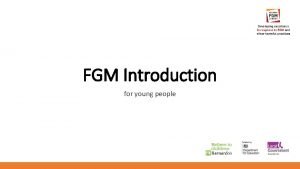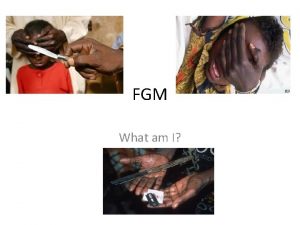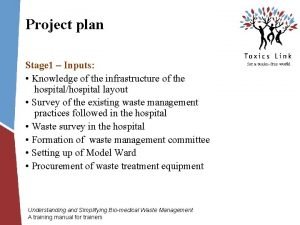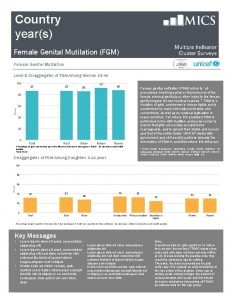Country years Female Genital Mutilation FGM Female Genital


- Slides: 2

Country year(s) Female Genital Mutilation (FGM) Female Genital Mutilation Level & Disaggregates of FGM Among Women 15 -49 100 92 87 87 86 Total Rural Urban 88 Female genital mutilation (FGM) refers to “all procedures involving partial or total removal of the female external genitalia or other injury to the female genital organs for non-medical reasons. ” 1 FGM is a violation of girls’ and women’s human rights and is condemned by many international treaties and conventions, as well as by national legislation in many countries. Yet, where it is practised FGM is performed in line with tradition and social norms to ensure that girls are socially accepted and marriageable, and to uphold their status and honour and that of the entire family. UNICEF works with government and civil society partners towards the elimination of FGM in countries where it is still pract 80 Percent 60 40 20 0 Richest Poorest Percentage of girls and women age 15 to 49 years who have undergone FGM/C*, by residence and wealth quintile *SDG 5. 3. 2 World Health Organization, Eliminating Female Genital Mutilation: An interagency statement, WHO, UNFPA, UNICEF, UNIFEM, OHCHR, UNHCR, UNECA, UNESCO, UNDP, UNAIDS, WHO, Geneva, 2008, p. 4. 1 Disaggregates of FGM Among Daughters 0 -14 years 100 80 Percent 60 40 32 33 34 28 33 25 30 30 Richest Poorest 20 0 Total Rural Urban No education Primary complete Secondary or higher Percentage of girls age 0 to 14 years who have undergone FGM/C (as reported by their mothers), by residence, mother's education and wealth quintile Key Messages • • • Lorem ipsum dolor sit amet, consectetuer • adipiscing elit, Lorem ipsum dolor sit amet, consectetuer adipiscing elit, sed diam nonummy nibh • euismod tincidunt ut laoreet dolore magna aliquam erat volutpat. Ut wisi enim ad minim veniam, quis • nostrud exerci tation ullamcorper suscipit lobortis nisl ut aliquip ex ea commodo consequat. Duis autem vel eum iriure dolor • Lorem ipsum dolor sit amet, consectetuer adipiscing elit, sed diam nonummy nibh euismod tincidunt ut laoreet dolore magna aliquam erat volutpat. Ut wisi enim ad minim veniam, quis nostrud exerci tation ullamcorper suscipit lobortis nisl ut aliquip ex ea commodo consequat. Duis autem vel eum iriure dolor Note: Prevalence data for girls aged 0 to 14 reflect their current, but not final, FGM/C status since some girls who have not been cut may still be at risk of experiencing the practice once they reach the customary age for cutting. Therefore, the data on prevalence for girls under age 15 is actually an underestimation of the true extent of the practice. Since age at cutting varies among settings, the amount of underestimation also varies and this should be kept in mind when interpreting all FGM/C prevalence data for this age group.

Female Genital Mutilation Type of FGM Trends in FGM 100 92 91 87 88 88 86 82 Sewn closed 77 80 Flesh removed 16 Percent 60 40 Nicked 20 2 Form not determined 0 45 -49 years 40 -44 years 35 -39 years 30 -34 years 25 -29 years 20 -24 years 5 0 15 -19 years 20 40 60 80 100 Percentage distribution of girls and women age 15 to 49 years who have undergone FGM/C, by type Percentage of girls and women age 15 to 49 years who have undergone FGM/C, by age cohort Attitudes to FGM National 100 Think FGM should continue 41 80 Think FGM should stop Percent 53 60 [CELLRANGE], [VALUE] 40 Say it depends / are not sure 2 [CELLRANGE], [VALUE] 20 Don't know / missing 4 [CELLRANGE], [VALUE] 0 Area 0 [CELLRANGE], [VALUE] 20 40 60 80 100 Wealth quintile Education of head of household Age Percentage distribution of girls and women age 15 to 49 years who have heard about FGM/C, by their attitudes about whether the practice should continue The Country Multiple Indicator Cluster Survey (MICS) was carried out in 2014 by the National Bureau of Statistics as part of the global MICS programme. Technical support was provided by the United Nations Children’s Fund (UNICEF). UNICEF and Name of other organizations providing financial support provided financial support. Percentage of girls and women age 15 to 49 years who have heard about FGM and think the practice should continue, by wealth quintile, education, residence and age The objective of this snapshot is to disseminate selected findings from the Country MICS 2014 related to Female Genital Mutilation (FGM). Data from this snapshot can be found in tables PR. 5. 1, PR. 5. 2 and PR. 5. 3 in the Survey Findings Report. Further statistical snapshots and the Survey Findings Report for this and other surveys are available on mics. unicef. org/surveys.



